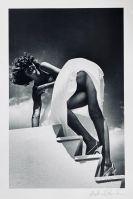
Details
Artist
Styles
// Leonard Freed’s Back Horse (1974) is a captivating black-and-white photograph that captures the essence of rural life and freedom. This archival print presents a vast, open landscape with a lone horse in motion, trotting along a dirt path with a sprawling village in the background, set upon a hillside. The composition leads the viewer’s eye from the horse in the foreground to the distant cluster of buildings, emphasizing the contrast between the solitary animal and the densely packed village. Freed’s skillful use of light and shadow highlights the natural textures of the field and the rustic path, creating a sense of timelessness and serene isolation. This photograph is a beautiful representation of the interplay between man-made and natural worlds, and it captures a fleeting moment of unrestrained movement within a static environment.
Back Horse, 1974
form
Medium
Size
24 x 30 cm
- Inches
- Centimeters
Edition
Price
- USD
- EUR
- GBP
Details
Artist
Styles
// Leonard Freed’s Back Horse (1974) is a captivating black-and-white photograph that captures the essence of rural life and freedom. This archival print presents a vast, open landscape with a lone horse in motion, trotting along a dirt path with a sprawling village in the background, set upon a hillside. The composition leads the viewer’s eye from the horse in the foreground to the distant cluster of buildings, emphasizing the contrast between the solitary animal and the densely packed village. Freed’s skillful use of light and shadow highlights the natural textures of the field and the rustic path, creating a sense of timelessness and serene isolation. This photograph is a beautiful representation of the interplay between man-made and natural worlds, and it captures a fleeting moment of unrestrained movement within a static environment.
- Recently Added
- Price (low-high )
- Price (high-low )
- Year (low-high )
- Year (high-low )
What is activist art?
Activist Art is a form of art created to address social and political issues. It often involves public engagement and works closely with communities to raise awareness or inspire change. While it can include elements of performance art, it is not limited to this form. Examples include creating and distributing social protest posters or organizing community-based art projects that highlight specific causes.














